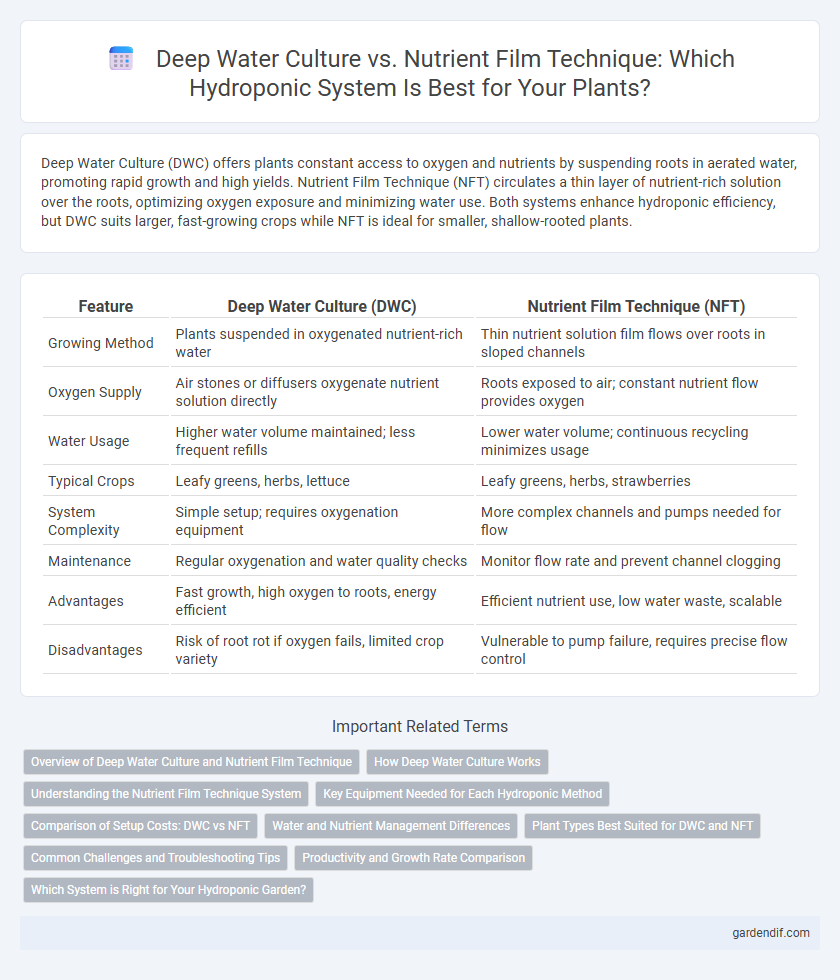
Deep Water Culture vs Nutrient Film Technique Illustration
Deep Water Culture (DWC) offers plants constant access to oxygen and nutrients by suspending roots in aerated water, promoting rapid growth and high yields. Nutrient Film Technique (NFT) circulates a thin layer of nutrient-rich solution over the roots, optimizing oxygen exposure and minimizing water use. Both systems enhance hydroponic efficiency, but DWC suits larger, fast-growing crops while NFT is ideal for smaller, shallow-rooted plants.
Table of Comparison
| Feature | Deep Water Culture (DWC) | Nutrient Film Technique (NFT) |
|---|---|---|
| Growing Method | Plants suspended in oxygenated nutrient-rich water | Thin nutrient solution film flows over roots in sloped channels |
| Oxygen Supply | Air stones or diffusers oxygenate nutrient solution directly | Roots exposed to air; constant nutrient flow provides oxygen |
| Water Usage | Higher water volume maintained; less frequent refills | Lower water volume; continuous recycling minimizes usage |
| Typical Crops | Leafy greens, herbs, lettuce | Leafy greens, herbs, strawberries |
| System Complexity | Simple setup; requires oxygenation equipment | More complex channels and pumps needed for flow |
| Maintenance | Regular oxygenation and water quality checks | Monitor flow rate and prevent channel clogging |
| Advantages | Fast growth, high oxygen to roots, energy efficient | Efficient nutrient use, low water waste, scalable |
| Disadvantages | Risk of root rot if oxygen fails, limited crop variety | Vulnerable to pump failure, requires precise flow control |
Overview of Deep Water Culture and Nutrient Film Technique
Deep Water Culture (DWC) hydroponics involves suspending plant roots in oxygenated nutrient-rich water, ensuring constant access to nutrients and oxygen for rapid growth. Nutrient Film Technique (NFT) uses a thin stream of nutrient solution flowing over the roots in a sloped channel, promoting efficient nutrient uptake and water recirculation. Both systems optimize hydroponic growth but differ in root immersion and nutrient delivery methods, impacting oxygen availability and system complexity.
How Deep Water Culture Works
Deep Water Culture (DWC) hydroponic systems operate by suspending plant roots directly in a nutrient-rich, oxygenated water solution, ensuring continuous nutrient uptake. An air pump supplies oxygen through air stones, maintaining optimal oxygen levels crucial for root respiration and growth. This method promotes rapid nutrient absorption and accelerated plant development compared to traditional soil cultivation methods.
Understanding the Nutrient Film Technique System
The Nutrient Film Technique (NFT) system circulates a thin layer of nutrient-rich water continuously over plant roots, ensuring optimal oxygen access and nutrient absorption. This method contrasts with Deep Water Culture (DWC), where roots are submerged in oxygenated nutrient solution, making NFT more efficient in water usage and ideal for small to medium-sized crops like leafy greens. Key advantages of NFT include improved root aeration, reduced risk of root rot, and easier monitoring of nutrient levels compared to the static environment of DWC systems.
Key Equipment Needed for Each Hydroponic Method
Deep Water Culture (DWC) requires essential equipment such as an oxygen pump, air stones, a large nutrient reservoir, and net pots to support plant growth in oxygen-rich, nutrient-dense water. Nutrient Film Technique (NFT) relies on a sloped channel system, a submersible pump to circulate a thin film of nutrient solution, and growing trays, creating a continuous flow environment ideal for the roots. Both systems demand quality nutrient solutions and pH control tools, but DWC emphasizes oxygenation equipment while NFT prioritizes efficient solution flow and root exposure management.
Comparison of Setup Costs: DWC vs NFT
Deep Water Culture (DWC) systems generally have lower initial setup costs compared to Nutrient Film Technique (NFT) systems due to their simpler design, requiring fewer components like pumps and channels. NFT setups demand a more precise installation of sloped channels and continuous nutrient flow systems, increasing complexity and upfront investment. Budget-conscious growers often prefer DWC for its cost-effectiveness, while NFT may appeal to those prioritizing space efficiency despite higher setup expenses.
Water and Nutrient Management Differences
Deep Water Culture (DWC) submerges plant roots in oxygenated nutrient-rich water, requiring constant aeration to prevent root suffocation and ensure efficient nutrient uptake. Nutrient Film Technique (NFT) involves a thin, continuous flow of nutrient solution over roots, enabling precise control of water and nutrient distribution while minimizing water use and preventing nutrient stagnation. NFT systems demand careful maintenance of flow rate and nutrient concentrations to avoid root drying or nutrient imbalances, contrasting with the more static but oxygen-dependent environment in DWC.
Plant Types Best Suited for DWC and NFT
Deep Water Culture (DWC) excels with larger, fast-growing leafy greens like lettuce, basil, and mint due to its constant oxygen-rich nutrient supply supporting robust root systems. Nutrient Film Technique (NFT) suits smaller, shallow-rooted plants such as strawberries, spinach, and herbs, benefiting from thin nutrient films promoting efficient nutrient absorption. Selecting DWC or NFT depends on plant root structure and growth rate, optimizing yield and health in hydroponic systems.
Common Challenges and Troubleshooting Tips
Deep Water Culture (DWC) and Nutrient Film Technique (NFT) both face challenges such as root oxygenation issues and nutrient imbalances, which can stunt plant growth. In DWC, root rot caused by low dissolved oxygen levels is common, so maintaining adequate aeration using air stones and pumps is crucial. NFT systems often experience uneven nutrient distribution, requiring regular monitoring of flow rates and system blockages to prevent nutrient deficiencies.
Productivity and Growth Rate Comparison
Deep Water Culture (DWC) systems provide plants with oxygen-rich nutrient solutions, often resulting in faster growth rates due to constant root immersion and optimal oxygen availability. Nutrient Film Technique (NFT) promotes steady nutrient flow over roots, enabling efficient nutrient uptake but can experience slower growth compared to DWC because roots are intermittently exposed to nutrients and oxygen levels. Productivity in DWC typically surpasses NFT in crops like lettuce and herbs, where rapid biomass accumulation and shorter harvest cycles are critical.
Which System is Right for Your Hydroponic Garden?
Deep Water Culture (DWC) provides plants with constant oxygen and nutrient-rich water, ideal for fast-growing crops and beginners due to its simplicity and low maintenance. Nutrient Film Technique (NFT) circulates a thin film of nutrient solution over plant roots, offering efficient nutrient uptake and better scalability for commercial or space-limited gardens. Selecting the right hydroponic system depends on your garden size, crop type, and desired maintenance level, with DWC excelling in growth speed and NFT optimizing nutrient delivery.
Deep Water Culture vs Nutrient Film Technique Infographic

 gardendif.com
gardendif.com